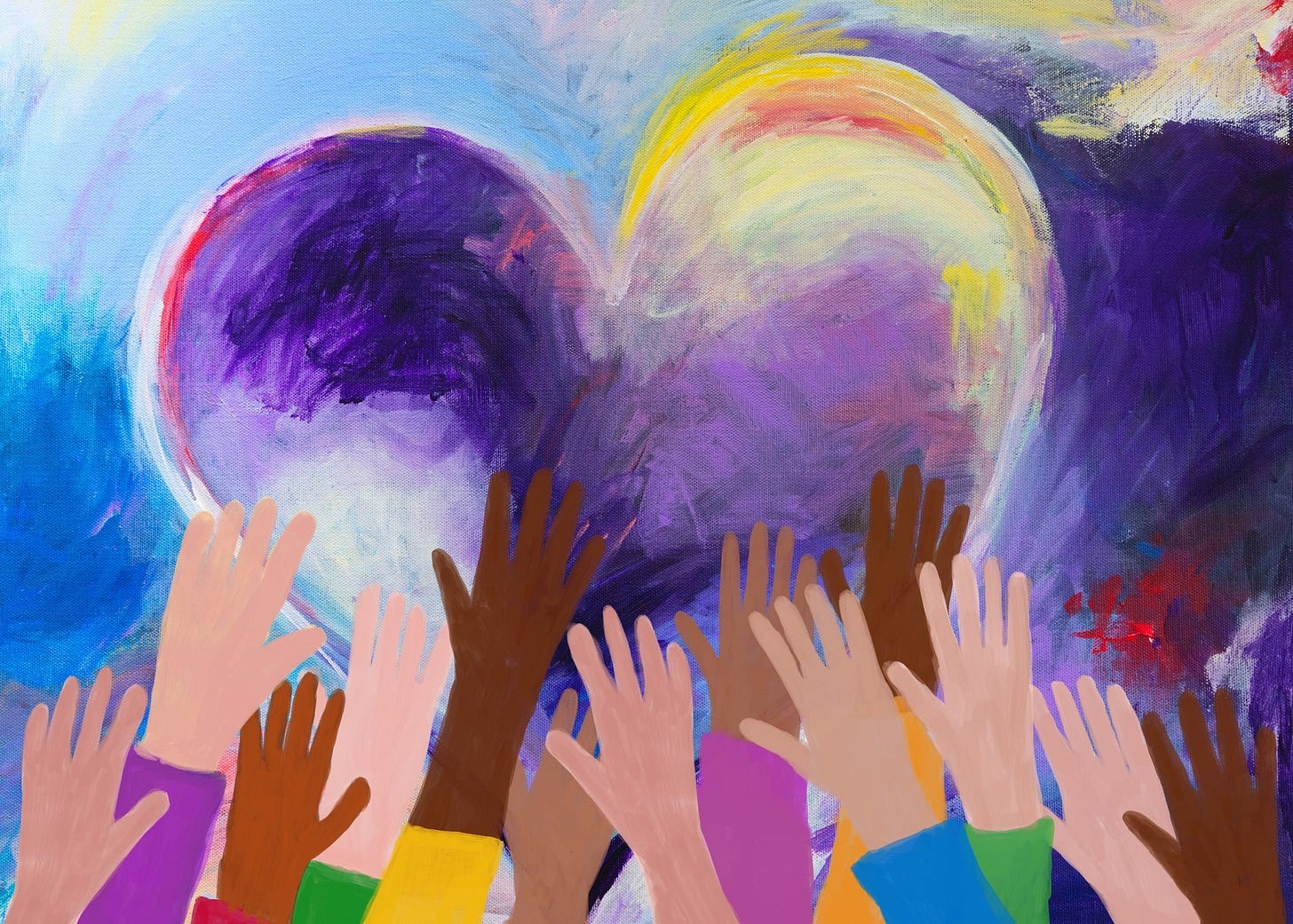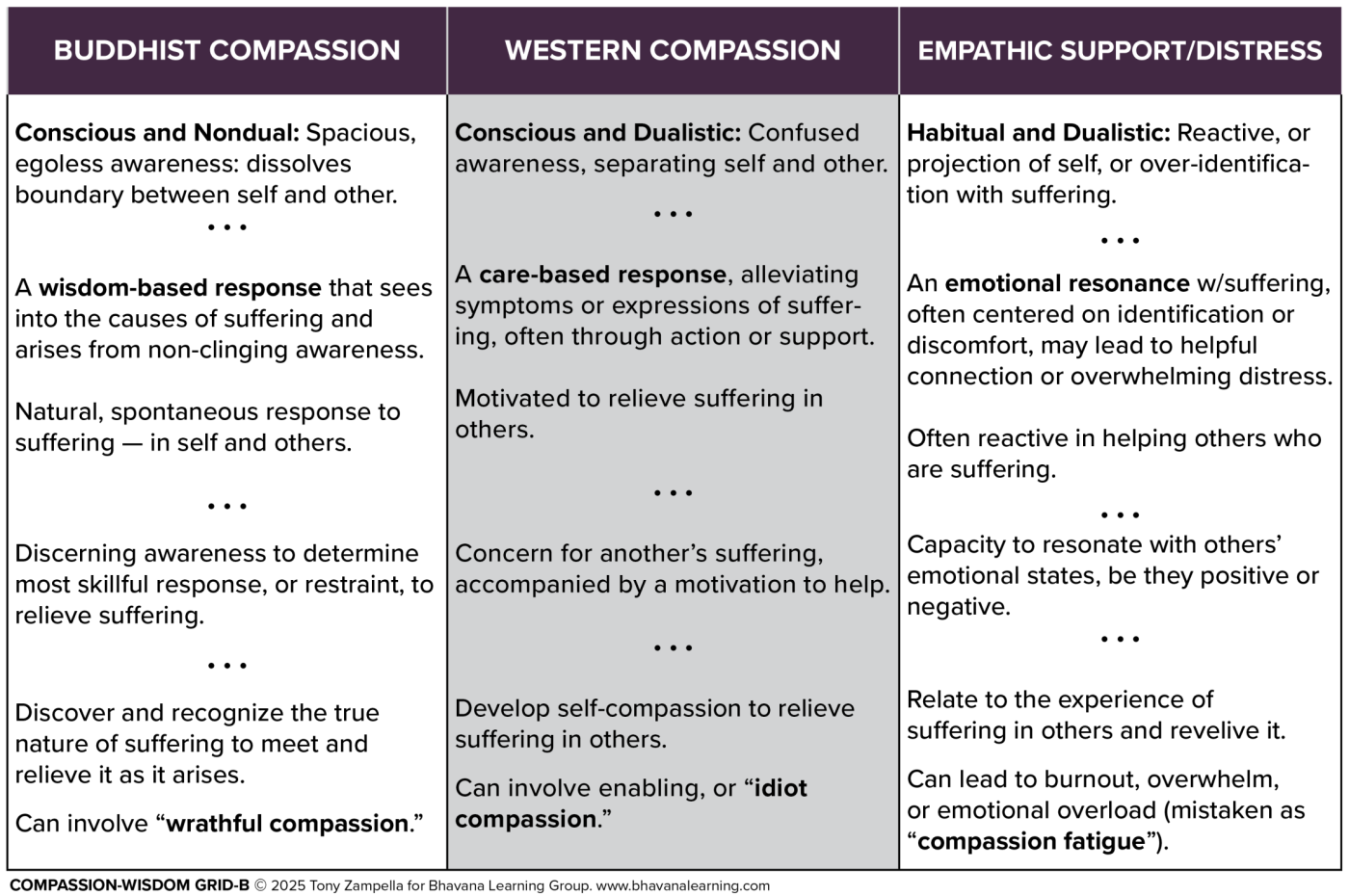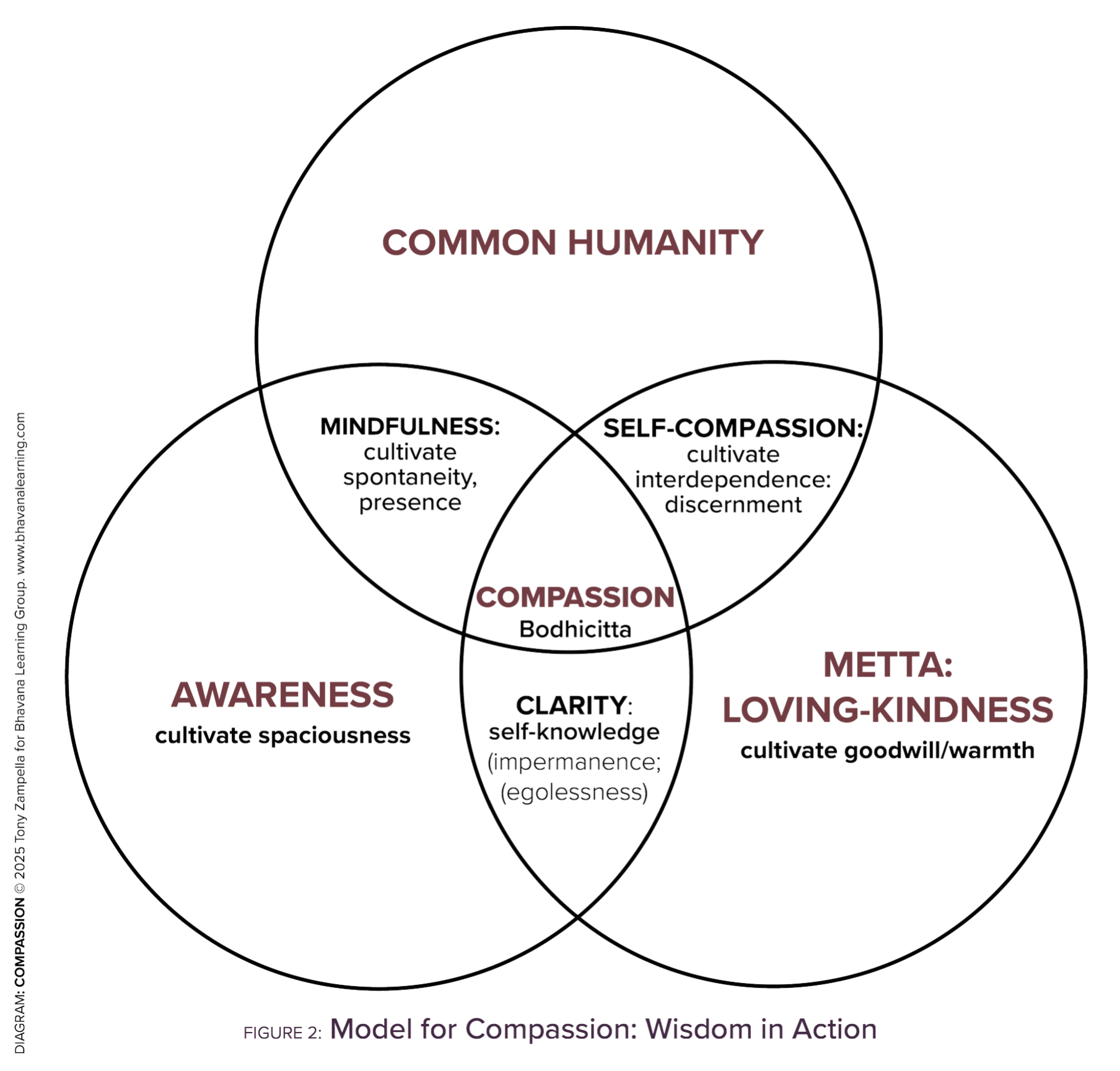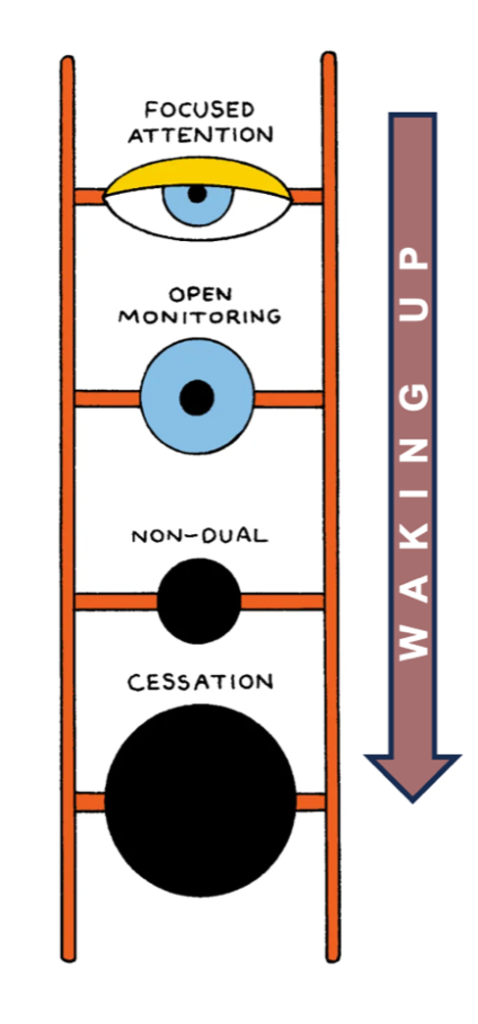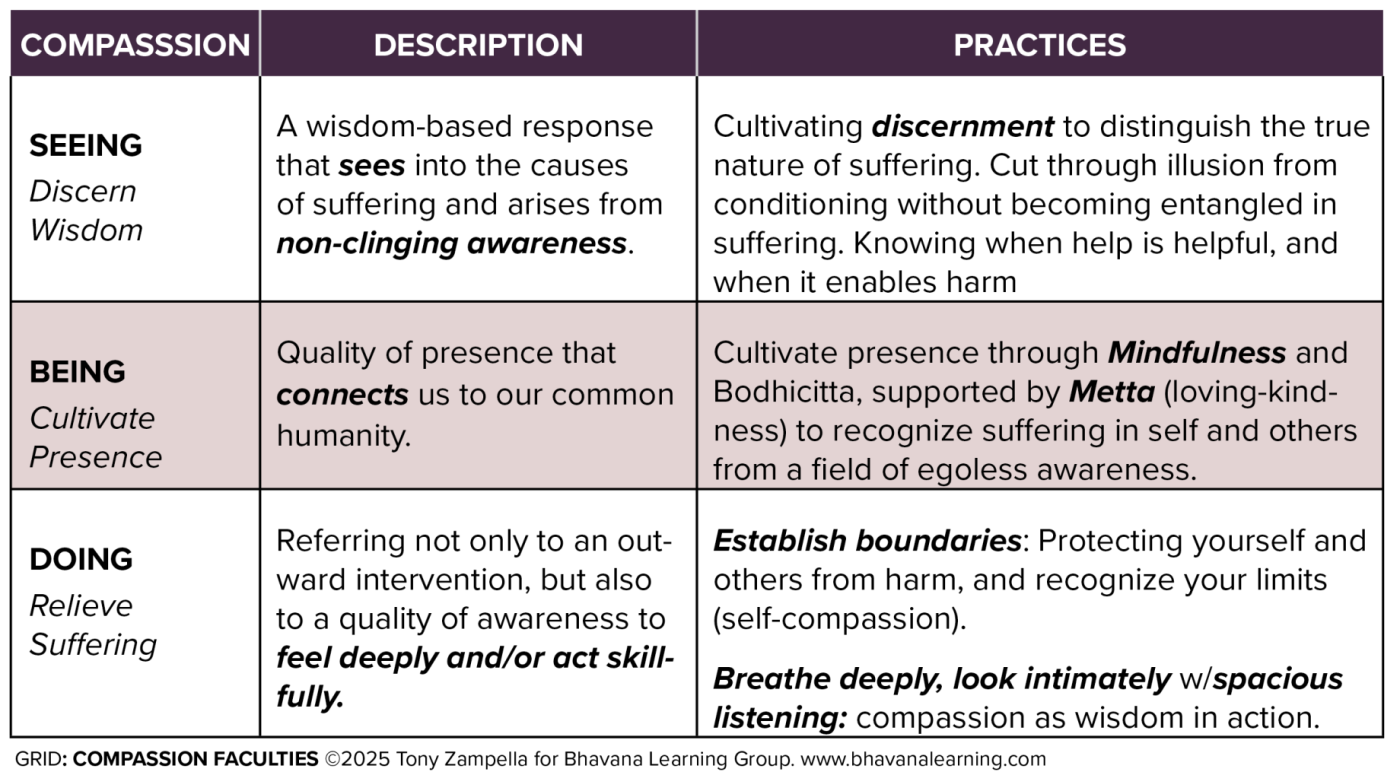Compassion as Wisdom in Action, Part 3: The Path to Common Humanity
SPECIAL SERIES: Distinguishing true compassion from emotional overwhelm and reclaiming its roots in wisdom.
This post ends a three-part special series exploring compassion as wisdom in action. Part 3 addresses some distortions of the Buddhist view, offering a fuller view of compassion as wisdom in action.
In a world shaped by chronic distraction and emotional exhaustion—especially in the workplace—compassion is often invoked as a remedy for suffering. But without wisdom, compassion can become performative, sentimental, or even harmful. To respond skillfully, we must first understand suffering and cultivate the awareness to meet it clearly.
In Part 1 of this series, we distinguished compassion from empathy, grounding it not in emotional resonance but in wisdom.
In Part 2, we examined Western and Buddhist views of compassion, focusing on dukkha—the Buddhist understanding of suffering—as a central insight.
Now, in Part 3, we focus on two large areas:
First, turning to modern distortions of compassion, such as "idiot compassion" and performative care. We also explore how wrathful compassion—fierce, discerning, and grounded—reveals a fuller expression of compassion as wisdom in action.
Second, we explore cultivating compassion by offering a structured approach with specific practices.
If this series succeeds, it will offer this broader view:
Compassion is a full expression of our humanity—a spontaneous movement of wisdom (seeing) that awakens deep presence (being), responding naturally to relieve suffering (doing).
Distortions of Compassion: Idiot and Wrathful Forms
First, we begin by confronting distortions. Two of the most significant are what master meditator, teacher, and author Chögyam Trungpa called idiot compassion and what Buddhist traditions (and modern psychology) describe as the fierce clarity of wrathful compassion.
Finally, we explore the process of cultivating compassion as “wisdom in action,” while venturing beyond our habitual views of action, including helping, performing, and doing.
Part 1: Idiot Compassion: Bypassing Truth
Trungpa coined the term idiot compassion, referring to misguided kindness that stems from the three poisons of grasping, aggression, and delusion, rather than true, wise compassion. It’s often described as well-intentioned but ultimately unhelpful, potentially enabling or accommodating negative behaviors or causing harm in the long run.
Without wisdom, idiot compassion masquerades as generosity or sensitivity, but in truth, it avoids discomfort—one’s own and that of others. It seeks to soothe rather than serve truth. We may fear hurting someone’s feelings or disrupting harmony, so we fail to set boundaries, tell the truth, or offer what is needed.
Buddhist teacher and psychotherapist John Welwood added another layer with his concept of spiritual bypassing—the use of spiritual language or practices to avoid psychological work. Introducing the term in the mid-1980s, Welwood described it as “premature transcendence.”
When we use compassion to bypass inner conflict, repressed emotion, or shadow material, we are not compassionate. We are avoidant.
In developmental psychology, this bypass often hides unresolved aspects of the self: the shadow. These parts of our psyche have been denied, repressed, or split off due to early wounding or stage-specific limitations. Idiot compassion and bypassing enable others to remain stuck, opting for harmony over wholeness and comfort over freedom.
True compassion does not fear discomfort. It is willing to confront pain, hold tension, and act with discernment—even when doing so is difficult.
Renowned Buddhist teacher, Pema Chödrön, emphasizes that idiot compassion often manifests when we avoid conflict to protect our image of being kind.
Common Signs of Idiot Compassion
Avoiding hard conversations to keep peace
Enabling harmful behaviors by not setting limits
Letting others cross boundaries in the name of kindness
Though well meaning, this kind of compassion can:
Prolong harmful behavior
Lead to emotional burnout
Damage relationships through unspoken resentment
Everyday Examples
Wise compassion is rooted in clarity, boundaries, and courage:
A few years ago, our firm conducted a 12-week coaching certification program. Midway through, based on participation, assignments, and attendance, we noticed that four of the 25 participants had fallen significantly behind—too far to catch up realistically. We could have hoped they’d improve, avoiding discomfort in the name of support. But that would have been “idiot compassion”: prioritizing feelings and being nice over the clarity and integrity of the program.
Instead, we invited each participant into a respectful conversation. We outlined the gap in requirements for completing certification, acknowledged their efforts, and offered an early exit, supported by two coaching sessions. After a day of reflection, all four accepted with relief —and the program’s integrity remained intact.
It was a hard call, but a compassionate one. Not enabling. Not avoiding. Just honest care, held with clarity and boundaries.
Wise compassion supports growth, even when it’s uncomfortable, as follows:
Idiot Compassion: A team member consistently misses deadlines. To avoid conflict, you cover for them, do extra work, and say nothing.
Wise Compassion: You express your concern clearly and kindly, name the impact, and suggest setting expectations or seeking support together.
Idiot Compassion: A family member makes repeated, hurtful comments. You brush it off to keep the peace and avoid rocking the boat.
Wise Compassion: You name the behavior respectfully, set a clear boundary, and explain what kind of engagement is okay for you.
Absent wisdom — discernment, clarity, and mindful presence — it can collapse into unwise compassion or empathic distress, a burnout or emotional overwhelm that originates from a lack of spacious awareness.
As Chödrön teaches, setting clear boundaries and knowing when to say “no” is sometimes our kindest action. True compassion may look fierce, but it’s grounded in care.
Part 2: Wrathful Compassion: The Fierce Face of Love
Whereas idiot compassion is too soft, wrathful compassion may seem too fierce. In the Vajrayana tradition of Tibetan Buddhism, wrathful deities, such as Vajrakilaya or Mahakala, represent compassion in its most protective, forceful form. They destroy delusion, not out of hatred, but love.
Wrathful compassion arises when harm must be interrupted, whether in the form of injustice, self-deception, or addiction. It may appear angry, but it is anger transmuted through wisdom. It is not reactive. It is precise, intentional, and grounded.
Contemporary psychologist Kristin Neff refers to this energy as “Mama Bear” compassion: the fierce, protective instinct that stands up for oneself or another when harm is present. This form of compassion sets boundaries, speaks difficult truths, and refuses to collude with harmful patterns. It doesn’t soothe; it liberates. An example:
In his book Cutting Through Spiritual Materialism, Trungpa critiques the ego’s tendency to co-opt spiritual practices and underscores the importance of wisdom in authentic compassion. He states that genuine compassion may appear “cruel or ruthless.” He emphasizes the role of prajna (transcendental wisdom) in discerning genuine needs over superficial wants to see past shallow appearances and recognize true suffering and need.
Wrathful compassion can be directed outward toward those who cause harm to themselves or others, or inward toward the parts of ourselves that sabotage or obstruct our growth. It is the sharp edge of love, uncompromising and clear-eyed.
Fierce Practice
This kind of compassion may be hard to recognize in everyday life, but it can be as simple—and as courageous—as a friend refusing to enable a harmful habit:
“I’m fine,” Darren said, brushing past him toward the fridge. “Just had a few. You don’t need to start.”
Marcus didn’t move. “You’re not fine,” he said, calm but firm. “You’ve been drinking every night for two weeks, and I’m not pretending it’s normal anymore.”
Darren laughed, defensive. “I don’t need a lecture, man.”
“No lecture,” Marcus replied. “But I’m not going to watch you unravel and call it loyalty.”
He held his ground—no yelling, no shame. Just presence, unmoving.
“I’ll drive you to a meeting,” he added. “Or I’ll call someone with you. But I’m not doing silence anymore.”
Darren didn’t respond—but he didn’t pour another drink.
Ironically, wrathful compassion may be an antidote to empathic distress. The key qualities of wise compassion can involve “wrathful” aspects, as follows:
Discernment: Knowing when help is helpful—and when it enables harm
Truthfulness: Being honest and direct, even when it’s hard
Boundaries: Protecting both yourself and others from harm
Self-Compassion: Recognizing your limits and honoring your own needs
Recognizing the signs of empathetic distress, setting healthy boundaries, and practicing genuine compassion to untangle the source of suffering can be crucial steps in managing and preventing emotional exhaustion.
Just as we must expand our emotional vocabulary around compassion, we must also question our assumptions about what compassionate action actually looks like.
Part 3: Is Compassion About Doing? Rethinking “Wisdom in Action”
Another common misunderstanding about compassion is that it involves outward, visible action. In many contemporary frameworks—especially in leadership, coaching, and wellness spaces—compassion is often contrasted with empathy by assigning action to compassion. For example, BetterUp describes empathy as “sharing the feelings of others” and compassion as “the act of showing kindness” or “taking action to help.”
This framing, while accessible, subtly reinforces the idea that compassion concerns doing—intervening, fixing, or performing kindness in a measurable or observable way. Though well-intentioned, this definition equates compassion with external behavior and overlooks its deeper origin.
From a Buddhist or non-dual perspective, this is a limited view. True compassion is not always about doing something externally—it may instead call for being someone internally: to be fully present, to be open, courageous, and willing to stay with suffering without trying to erase or escape from it. The most compassionate acts might be inner stillness, silent presence, or the refusal to act prematurely.
Inner actions—such as the right intention, right effort, non-harming, renunciation, and goodwill—are not passive. They are potent internal movements rooted in mindfulness and ethical clarity. They shape how we listen, how we speak, how we withhold action when needed, and how we hold space for others without distortion.
When we describe compassion as “wisdom in action,” we are referring not only to an outward intervention, but also to a quality of awareness that moves from inner awakening. This form of action is not an egoic project, reactive, or performative. It does not emerge from our discomfort or the need to be perceived as helpful. It arises from the intentional motivation of bodhicitta—the awakened heart that sees clearly the nature and complexity of suffering (see Fig. 2 below).
In this way, wise compassion transcends the false divide between doing and being. This quiet strength acts when needed—and remains still when action distorts the truth. It is the natural, grounded movement of presence—one that may or may not take external form but is always rooted in deep inner alignment.
Cultivating Compassion
In a previous blog, I explored practices for cultivating compassion. Two foundational pillars of mindfulness and recognizing common humanity (see Fig. 2 above) create the conditions for compassion to emerge, not as forced behavior but as a spontaneous expression of wisdom. Since then, I've added a third pillar: Metta meditation to highlight the focus on cultivating the inner wisdom of our loving mind.
1. Mindfulness: The Inner Path Toward Compassion
To discern the wisdom that underpins true compassion, we must understand mindfulness in its original context—rooted in the Four Noble Truths and the ethos of the Eightfold Path. In this framework, mindfulness (sati) is not simply about relaxation or awareness of the present moment. It is part of an integrated path that includes right view, right intention, right effort, right action, and right concentration.
Anchored in these principles, mindfulness supports a spacious, egoless awareness—the ground from which wisdom and compassion naturally arise. In our firm’s work with professionals, we’ve observed that people often adopt mindfulness or breathing practices for one of three progressively deepening reasons:
Focus: Cultivate attention to relieve stress and stabilize the mind–body
Open Monitoring: To develop intimacy with mental and emotional patterns
Non-Dual Awareness: To uproot the causes of suffering and glimpse liberation
These stages unfold sequentially. The first and most common is stabilization to quiet the system. Then, open monitoring cultivates intimacy with one’s inner life, revealing patterns, beliefs, and habits. With time, gentleness, and further study and reflection, this awareness can deepen, illuminating the defilements and attachments at the root of suffering. This is the terrain of spiritual insight and, ultimately, cessation—the freedom described in the Dharma.
Recent cognitive science is beginning to map this process. A comprehensive 2024 Vox feature profiled research by cognitive scientists Ruben Laukkonen and Heleen Slagter, who developed a model showing how both simple breathing practices and advanced meditative states transform consciousness. I’ve slightly adapted their visual (see right), which outlines a compelling arc of process, practice, and path.
What’s most promising is that this research doesn’t reduce meditation to stress management. Instead, it offers that avenue and affirms its depth of intention, including how it cultivates compassion. When I took Stanford’s Compassion Cultivation Training over a decade ago, I was struck by this same insight: The path to compassion begins inward. Through mindfulness, we cultivate presence; through lovingkindness, we soften the self. Through connection to common humanity, we awaken the natural impulse to care (see Fig. 2 above).
This approach honors compassion not as a vague feeling or moral stance but as a grounded human capacity rooted in awareness, nourished by discernment, and activated in response to suffering.
2. Metta: Cultivating the Loving Mind
Mettā (or maitrī in Sanskrit) originates from Pali, the language of the earliest Buddhist scriptures. This word translates to “lovingkindness,” or “goodwill.” It’s a state of mind characterized by a deep wish for happiness and freedom from suffering for all beings, including oneself.
Metta is the foundation of the “four immeasurables.” Thich Nhat Hanh emphasizes that true love, as taught by Buddha, encompasses the Four Immeasurable Minds: lovingkindness, compassion, joy, and equanimity.
Importantly, metta bridges mindfulness and our sense of common humanity. It cultivates an awakened heart that is open, spacious, and connected—a loving mind of goodwill that deepens both awareness and understanding.
Author and metta meditation teacher Sharon Salzberg views the practice of lovingkindness as “the enlivening power of connection, of love, of intimacy” to cultivate a life of compassionate nonharming:
When we dedicate ourselves to actions that do not hurt ourselves or others, our lives become … a “seamless garment” with nothing separate or disconnected in the spiritual reality we discover. To live with integrity, we must stop fragmenting and compartmentalizing our lives.
Using phrases or mantras, we learn to reveal our conditioning and support, cultivating our true nature and loving mind. Traditional phrases, such as “May I (or you) be free from danger, be happy, be healthy, and live with ease,” help counteract ill will with intentional goodwill.
Practicing phrases in meditation expands the field of awareness, preparing the mind for daily life. As you move through the day, silently offering “May you be well” when irritation arises can soften reactivity. Likewise, in moments of self-judgment, the phrase “May I live with ease” can gently loosen harsh self-criticism and return you to spaciousness.
This cultivated awareness softens the solidity of our separate selves and prepares the ground for a deeper connection with the second pillar: common humanity.
3. Common Humanity
When we find ourselves impatient, upset, or unsettled, we can pause to reflect on where we may be clinging—overidentifying with an experience, a goal, or a fixed identity. The act of softening—letting go—creates space. In that space, we remember that we are not alone in our suffering or striving. We share a human experience marked by joy and sorrow, fear and hope, confusion and clarity.
Zen Buddhist poet and priest, Norman Fisher, speaks to common humanity in his book "The World Could Be Otherwise":
"Compassion isn't only me benefiting you. It's us together, swirling in and out of each other in the expansive ever-connectedly… I'm not just me. You're not just you. My I and your you depend on each other. One can't exist without the other."
Recognizing our common humanity invites interdependent awareness. It shifts us from isolation to connection and from judgment to understanding. As author and teacher Chödrön states, “[O]nly when we know our own darkness well can we be present with the darkness of others. Compassion becomes real when we recognize our shared humanity.”
Compassion as Practice
We can learn to recognize common humanity – such as imagining the fears, hopes, and desires of those with you on the freeway (above) – through mindfulness and metta. Moments of awareness, attention, and breath become important practices that cultivate clear seeing, returning us to the spaciousness of our true nature. With it, the natural impulse of compassion emerges.
For professional healers, compassion is a lived commitment, not a tool. It accesses our true nature and requires our attention, intention, and presence. Zen master Thich Nhat Hanh says, “We [must] practice mindfulness, deep listening, and deep looking to develop compassion.”
Practices to cultivate compassion center on mindfulness, which cultivates nonreactive awareness and recognizes the true nature of reality. Meditation supports awareness and intimacy with our mind, while lovingkindness cultivates common or shared humanity. Other practices include boundaries and self-care, which cultivate openness, presence, and connection.
Thupten Jinpa, Ph.D., is the Dalai Lama’s principal English translator and author of the course Compassion Cultivation Training (CCT). Jinpa posits that compassion is a four-step process, which I’ve paraphrased slightly:
Awareness of the true nature of suffering
Sensitive concerns related to being moved by suffering
A wish to see that suffering relieved
Wise responsiveness or readiness to help relieve that suffering
Conclusion: Reclaiming Compassion as the Path to Liberation
Compassion is a full expression of our humanity—a spontaneous movement of wisdom (seeing) that awakens deep presence (being), responding naturally to relieve suffering (doing).
Compassion, rightly understood, is not soft, sentimental, or self-sacrificing—and it is certainly not a performance, tool, or technique.
It is a powerful expression of wisdom: a spontaneous, active, discerning, and natural response to suffering that arises from recognizing the truth of our common humanity.
It is not bound by emotion or morality, but rooted in bodhicitta—the awakened heart–mind that longs for freedom for all beings.
To practice true compassion is to see clearly, feel deeply, and act skillfully. It is to cut through illusion born of conditioning, to hold suffering without becoming entangled in it, and to respond from spaciousness rather than reactivity.
As we reclaim compassion from its distortions—overidentification, avoidance, aggression, sentimentality, or moral duty—we uncover a deeper power: one that holds both tenderness and ferocity. One that comforts and confronts. One that sees clearly and acts freely.
Compassion is not a performance. It is the awakened heart in motion.
Reading Time: 13 min. Digest Time: 18 min.
1- VIEW OUR RELATED RESOURCES & BLOGS:
Compassion as Wisdom in Action, Part 1: Beyond Empathy
Part 1: A Multimedia Package: Beyond Empathy
Compassion as Wisdom in Action, Part 2: The Nature of Suffering
I’m Tony V. Zampella —a teacher, wisdom coach, and leadership development consultant. I support accomplished professionals in turning a corner: expanding their inner lives to align with deeper purpose, presence, and impact.
My work blends Buddhist psychology with philosophical inquiry to support contemplative learning: reflective, embodied practices that cultivate awareness, presence, and meaning in both personal and professional life.
Contact Tony at Bhavana Learning Group



